Interplex, the complex assemblies expert, on power electronics, the automotive industry and the continuous drive for smarter design
Power modules containing high-power insulated-gate bipolar transistors (IGBTs) are at the core of most modern inverters. These modules are the electronic muscle of the system. They perform all the switching, and they generate all the heat. But built around the muscle are subassemblies of components – control boards, current sensors, capacitor banks, busbars, cooling circuits – which are combined to make a fully functional inverter. Together, they are often referred to as an inverter assembly, or, in some cases, a powerstack.
If you dig under the hood of some early hybrid vehicles, you will find a big power module at the center, surrounded by discretely packaged subassemblies, all of which are tied or connected together by ribbon cables, harnesses, fasteners and power bussing systems.
Since the development of those early hybrids, the technology has advanced and engineers have learned to package the subassemblies in smarter, more efficient ways. “The first step was to take the control board and stack it right on top of the power module,” Joe Lynch, Director of Advanced Applications Engineering at Interplex, told Charged.
As products cycled through the next decade of design iterations, the inverter evolved into one tightly packaged consolidated unit. “Now, the newest trend is to take the power module and all the supporting subassemblies and design them to be integrated together as an overall package, reducing the size of the complete inverter system,” said Lynch.
These smaller integrated inverter assemblies decrease material costs, improve the assembly process and result in shorter current paths between subassemblies, thereby greatly improving overall performance and increasing efficiency.
As new CAFE standards drive the market towards more cost-effective hybrid and alternative powertrain vehicles, the pressure to improve inverter system efficiency has intensified. “Efficiency and cost are at the heart of upgrading these inverter systems,” Lynch said. “Finding a way to reduce overall inductance and size and improve manufacturing methods for a packaged inverter system becomes critical.”
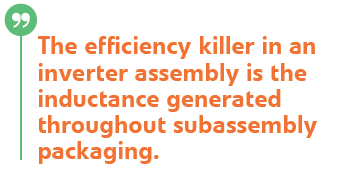

As the market continues to focus on improving the active devices – IGBTs, MOSFETS, SiC- and GaN-based switch devices – much of the efficiency gains at the chip levels could be lost if the overall packaging and interconnection is not addressed. “The efficiency killer in an inverter assembly is the inductance generated throughout subassembly packaging,” Lynch explained. “Reducing inductance can be achieved through shorter current paths, larger and less conductors, and smaller overall size and proximity of components in the assembly. This is especially important with current running through parallel buses. Only by addressing the inverter assembly – both the active and the passive components – as one interconnecting package with overall design consolidation, can maximum efficiency be realized.”
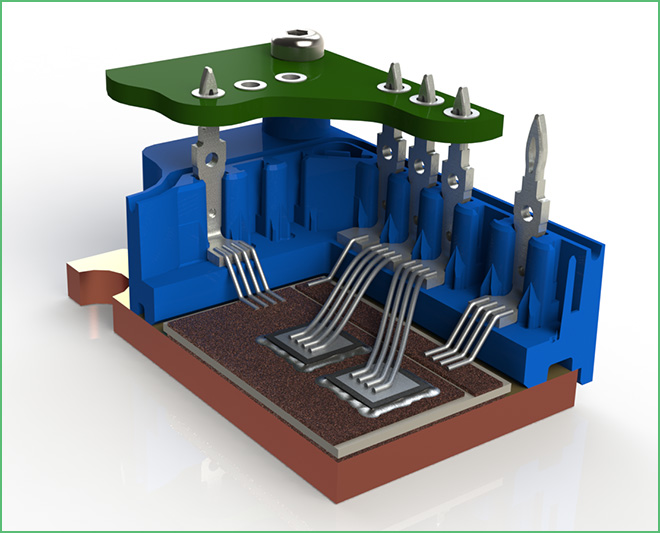

Driving better design
Although significant progress has been made in inverter packaging technology, there is still room for improvement. “If you look at most consolidated inverter assemblies, termed by some as ‘powerstacks,’ you see a lot of nuts, bolts, screws and soldered connections,” Lynch says. “Ideally, inverters will have less of those type connections in the future, and systems will be designed that are more integrated and permanently plug together as an assembly.”
Interplex’s work in the power module industry has primarily focused on supplying lead frames, press-fit solderless interconnects and integrated packaging to the module makers. For power modules, the general industry standard for interconnection and assembly remains one of a soldered connection. However, finding an alternative to soldered connections has been a focus of the power module industry for many years, mainly because of the assembly needs of the power module customer. Inherent in a power module design is its ability to dissipate heat, and the introduction of heat necessary to solder to control boards during assembly can be excessive, and cause damage to the assemblies. Solderless, high-force pluggable connections – like Interplex’s press-fit technology – have been gaining a lot of ground recently due to their ability to be assembled without the introduction of heat.
There is another advantage of solderless press-fit technology that benefits the rest of the inverter’s subassemblies: it eliminates cumbersome connection systems, such as harnesses, bolting, welding and other costly and inefficient connections. “A lot of companies use these high-force pluggable interconnects in power modules,” explains Lynch, “but they’re not using them to create the whole power module system, which includes the busbars, capacitors, current sensors, etc. A lot of these subsystems are still put together with, basically, a nut-and-bolt combination.”
Bolting, welding and harness connections are assembly-process intensive, and result in larger assemblies with longer current paths and higher overall inductance. Interplex believes the full integration of pluggable press-fit technology could significantly reduce the bill-of-material costs, decrease assembly complexity and shrink the overall physical size of the power assembly.
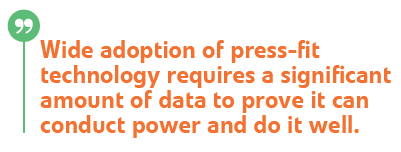

“Wide adoption of press-fit technology requires a significant amount of data to prove it can conduct power and do it well,” said Lynch. “Can it handle vibrations, heat and thermal cycles? Our testing over the years shows that it can. Now, it’s a question of engineering new designs for high-force, resilient, pluggable interconnects to take it to the next level of efficiency.”
Conductivity
Press-fit designs come in many formats, such as webs, formed, and split beam “eye-of-the-needle” (EON). All have tradeoffs, and it is important to match the performance characteristics to a particular application. Test data availability is the ultimate verification.
For power connections in robust and harsh environments, Interplex says that engineers often prefer high-force solderless connections like press-fit because of their ability to meet vibration and temperature profiles beyond 150° C. These press-fit type connections are repeatable, make direct contact with the printed circuit board (PCB), and are available in various alloy options that support high current.
The ability of the assembly to dissipate heat, particularly in a power assembly, plays one of the most important roles in contributing to a connection’s current-carrying capacity. It was once thought that solderless connection technologies carried less current than a soldered joint, but the new generation of high-normal-force press-fit connections allow direct contact with the plated-through holes of a PCB, allowing current and heat to pass without the medium of solder in between.
Conductivity is related to three key considerations when using press-fit technology: size, material selection and thermal dissipation. To highlight some of the design options available to engineers, Interplex uses a simulation (Figure 1) of a typical copper flexible press-fit terminal with three possible alloys of varying thermal conductivity. Temperature gradients reveal the most cost-effective alloy for the power requirements, and the company says that physical tests were used to verify the results.
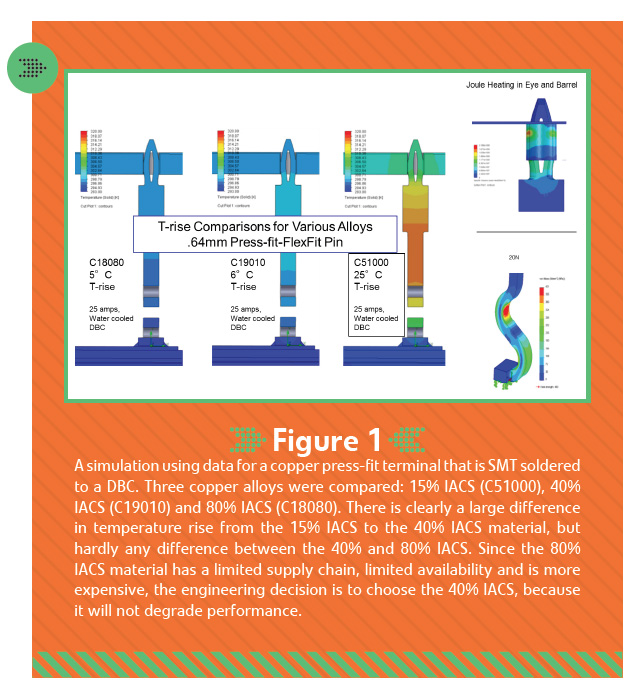

Mechanical fortitude
The vibration, maximum acceleration and thermal environments of the automotive industry have driven advancements in press-fit interconnects, with a focus on increasing the normal force and maintaining resiliency. The latest developments of EON press-fits offer resiliency with high normal force and stable contact resistance typically under 0.5 mΩ for the product life. In fact, Interplex claims that, following tests under an automotive vibration profile and a temperature range of -40 to 150° C, the average contact resistance remained well below 0.2 mΩ. These characteristics make high-force contacts very capable of power applications.
Copper compatible?
The copper bus systems in power assemblies enable high current transmission with low losses and a good level of heat transfer. However, connecting to the busbar systems has, until recently, been a difficult process. According to Interplex, there has been a slow adoption of press-fit connections used directly with copper busbars, mainly because of a misconception that, over time at high temperatures, the copper creep (or its tendency to move slowly and deform permanently) will weaken the interconnect and degrade overall performance.
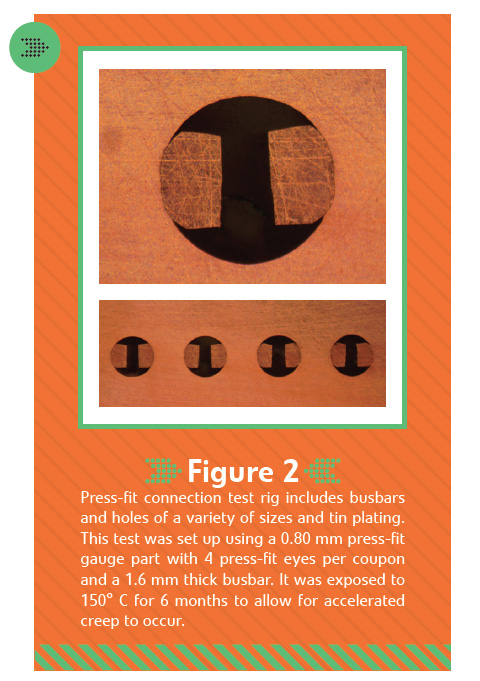

To combat this perception, Interplex has been conducting accelerated creep testing and publishing the results. In a series of tests, multiple holes were created in copper busbars that ranged from just above to just below the standard tolerance window for the press-fit part (Figure 2). Normal forces of the press-fit test coupon were evaluated before and after prolonged temperature soaks, and the interconnects maintained resiliency throughout the cycle. Final normal forces were well within an acceptable range for a well-functioning power connection (Figure 3).
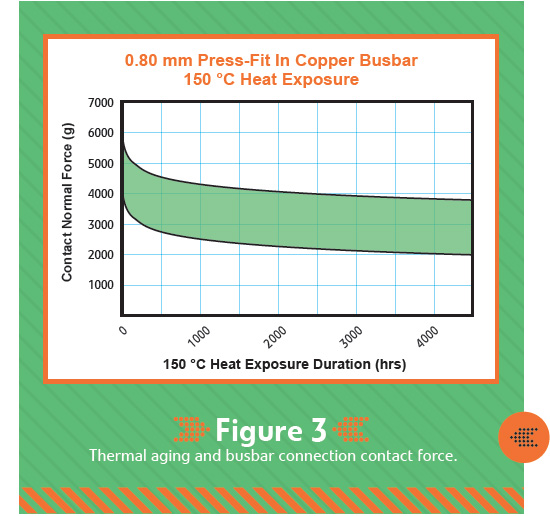

Even though existing test results verify that the functionality of the high-force press-fit connection is well maintained through the creep of the copper busbar, Interplex continues to define additional test variations for more aggressive environments.
The results suggest that high-force and high-power solderless interconnects can be realized for many types of busbar connections, opening the design window for more solderless designs to be developed with the target of carrying even more current.
In-house power moves
As the worldwide auto industry continues its trend towards electrification, more and more automakers are vertically integrating their power electronics development. Power Module manufacturers have been hesitant to offer completely packaged inverter systems, as OEMs are looking for specialized units to fit the design of their future car lines. As a result, OEMs have been hiring engineers to build up their electric motor and inverter know-how in an attempt to drive down costs and increase efficiencies. However, when it comes to the fully-integrated inverter assembly, expertise in packaging and connector engineering is needed as well.
“The OEMs are moving towards designing their own power modules from the ground up, as an integrated complete powertrain,” Lynch explained. “In the end, they want to control and build the power circuits themselves and buy the packaging parts for assembly in their own factories.”
However, while the OEMs are climbing up the learning curve, they continue to rely heavily on suppliers for their power electronics and packaging expertise. For Interplex, that expertise is leading to a solderless, more integrated design of the future.
This article originally appeared in Charged Issue 17 – January/February 2015


















































